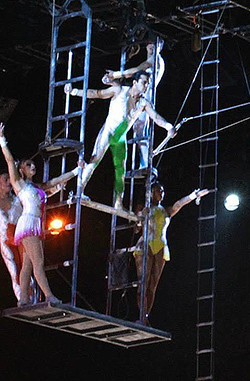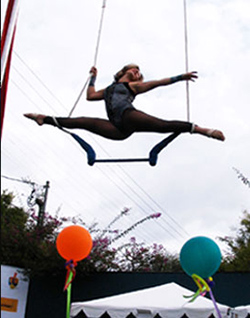Ask NASA Climate | July 18, 2014, 12:41 PDT
Flirting with gravity

Like a rocket, Ammed, an aerialist from the Ringling Bros. and Barnum and Bailey's Tuniziani Troupe, shoots toward the sky. Credit: Richie Gaona
“If you release the fly bar too early,” explains Richie Gaona, fourth-generation trapeze artist turned trainer, “your trick will go long and you risk banging into the catcher.” We are standing near the net talking about timing. He tosses a gardening glove into the air. It spins and lands a few feet away.

“If you hold on too long, then your trick is short and you’ll miss.” Someone brings back the glove and he throws it again. It goes up spinning, but this time travels backwards. “If you let go at just the right moment, you get vertical lift, then a moment of stillness and end up a perfect arm's distance from the catcher.” The glove goes up, spins twice, and lands squarely where he intended with a satisfying plunk.
When people find out that I work at NASA and fly trapeze, they’re surprised that I have such diverse interests. I don’t see it that way: It’s the same sky, just a different type of rocket.
Richie’s "timing" explanation uses the same principles of physics that NASA uses to deploy many of its spacecraft. A combination of physics and timing is what accounted for the tight 30-second launch window of NASA’s Orbiting Carbon Observatory-2 (OCO-2) earlier this month. OCO-2 must arrive in the A-Train lineup as precisely as a trapeze artist performing a complex acrobatic trick. Two other NASA Earth science missions launching this year, ISS-RapidScat and CATS, will exploit the same science and math equations for their meticulous rendezvous with the International Space Station (ISS).
I never did run away to join the circus. But Kristin Finley, the girl I stood next to for so many years on the platform (just another term for "launch pad"), made it all the way to the top. Although our journeys seem like worlds apart, they're actually more like a parallel universe.

To me, NASA is enough like soaring through the air, shooting for the sky and flirting with the forces of gravity. And even though Kristin has traveled all around the globe, just like one of NASA’s Earth-orbiting satellites, the trapeze troupe she performs with came back into town this week.
So, for a day I ran away (a couple miles downtown, actually) to get swept up in flight, up in the air, thrusting into space and reaching for the sky.
Why do trapeze artists do what they do? The same reason we do what we do at NASA. It’s the attraction to what seems impossible; the relationship with space, to leave the ground and go upward, going as high as you can; to push boundaries using a combination of physics and sheer determination.
We push ourselves for the pure joy of pushing, and the hope that those who watch will be moved and inspired; that someone, somewhere, might see what we’re doing and consider pushing beyond their perceived limits, real or otherwise.

As always, I look forward to your comments.
Laura
OCO-2, ISS-RapidScat and CATS are part of NASA's Earth Right Now campaign, a series of five Earth science missions that will be launched into space in the same year, opening new and improved remote eyes to monitor our changing planet.
